by Tom Gaylord
Writing as B.B. Pelletier
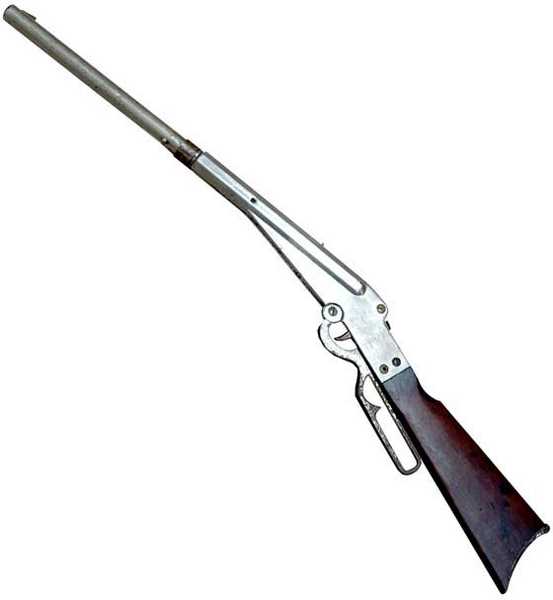
The Heilprin Columbian Model E BB gun is one few people have seen.
This report covers:
- Heilprin history
- Today’s gun
- Sheet metal fabrication
- Trigger safety
- BB caliber?
- Money in the bank
- What’s next?
Sometimes BB finds an airgun that few people have seen. Today is one such time. The Heilprin Columbian Model E lever action BB gun was made from 1914 to 1920 and according to the Blue Book of Airguns, maybe 50 or more probably survive. I’m not so sure about that number, but I know I’ve only seen a few at airgun shows. So when this one came up on Gun Broker a few weeks ago, I bid on it an won it. I don’t think there were any other bidders. I think they stayed away because they didn’t know what it is and they didn’t have the library to look it up.
I have seen more of an earlier Model M (1910-1914) at airgun shows. Dr. Dunathan (he wrote the book The American B.B Gun) says the Model M is rarer than the gun I’m reviewing today, but for some reason, there seem to be more of them around.
Both guns are 1000-shot BB repeaters. That’s very high-tech for their timeframe. Even BB repeaters weren’t that common back then.

The 1910 Heilprin Columbian Model M BB gun is the slightly more common one, in my experience.
Heilprin history
William Heilprin of Philadelphia was a businessman who probably was the money behind the guns that Elmer Baily invented. Early Heilprin BB guns are the ones that have the cast iron frame with intricate scrollwork and animal figures cast into the receivers.
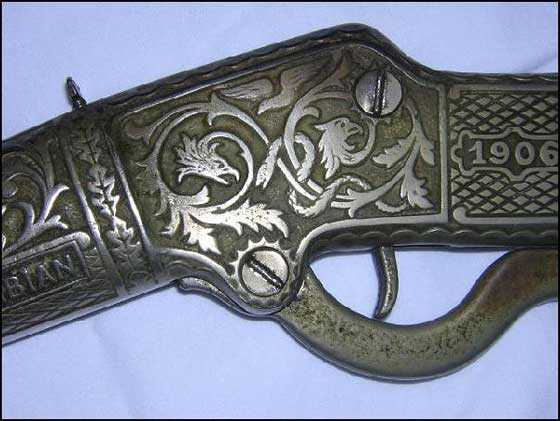
This Heilprin Columbian Model 1906 BB gun receiver is very recognizable among BB gun collectors.
Today’s gun
The BB gun we are looking at today is small. It’s about the size of a Daisy 105, which is a small youth BB gun. It’s nickel-plated over the entire surface and has a wooden buttstock. It’s 33-1/2-inches long and weighs 2 lbs. 5 oz. The finger lever is quite small and obviously sized for young hands. It’s painful to try to hold the rifle by grabbing through the lever, but iot can be held on the outside. Also, the triggerguard is so small there isn’t much room for a finger.
The gun is made from sheet metal that’s nickel-plated over all the metal. It looks striking today, but in 1914 that was a common finish for a BB gun.
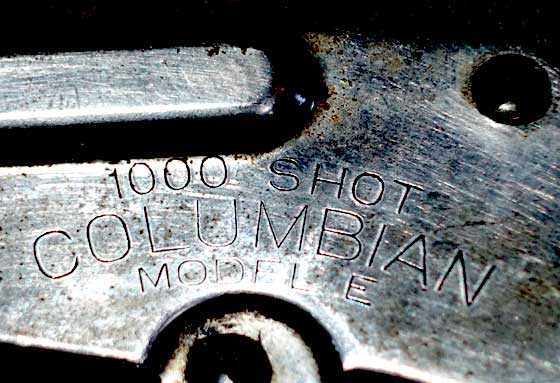
Left side of the receiver tells the model.
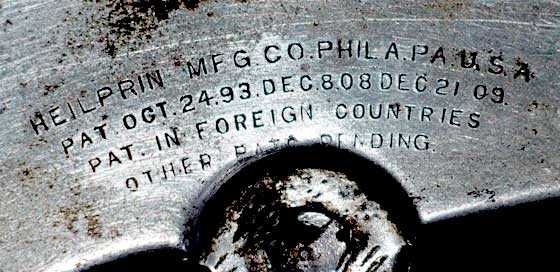
Right side gives the patent information.
The gun loads through a hole in the barrel, just forward of the receiver. A sliding cover is slid forward to expose the hole for loading, then slid back to keep BBs from falling out. This cover is held in place by friction and appears to be made of spring steel.
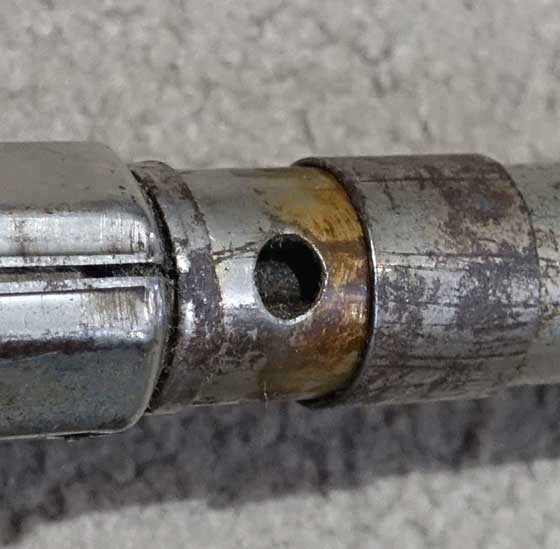
Just forward of the receiver on top of the barrel is the loading hole. Slide the cover forward and pour in the BBs. This may be a good place to oil the gun, too.
Sheet metal fabrication
In fact, the entire gun is a study in the history of sheet metal fabrication. If you examine it carefully you see holes that are punched in to fold the metal, stiffening the parts. There are also depressions punched into the metal that obviously hold internal parts in place. There is even one primitive rivet peeking out from the inside, where it must hold something critical in place.
The receiver is made in two half-sections that are stamped, rather than being folded around a mandril in a single piece the way Daisys were. The barrel is folded as a single piece. Where the ends of the barrel come together, the gun is open. Through the receiver halves I can peek at the mechanism inside. In 1913 Daisy perfected a method of welding thin sheet metal so they could make the barrels and compression chamber on their BB guns air-tight, but this gun doesn’t show that. I can see a sheet metal tube inside the two receiver halves that has to serve as the compression chamber, since the outside of the gun cannot be sealed air-tight.
Trigger safety
Above the receiver at the top of the wrist is a sheet metal button that must be depressed for the trigger to work. It’s identical in function to the thumb safety that Sheridan would use in the 1950s, only on this gun I find it much easier to reach. Perhaps that’s because of the small overall size of the gun? I don’t know, but it is an interesting look into the history of airguns.
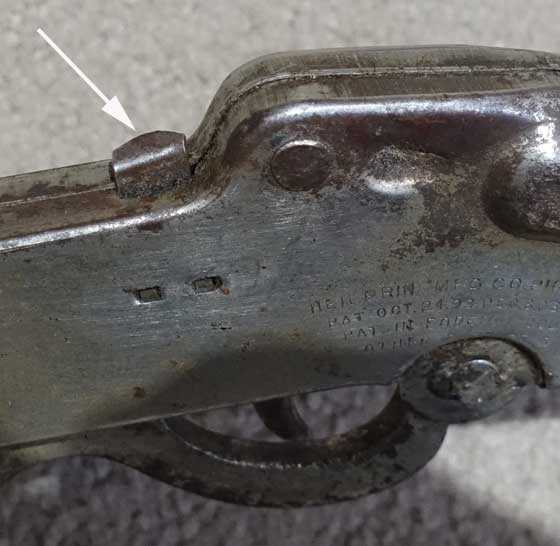
There is a trigger safety (arrow) that must be depressed for the trigger to function.
BB caliber?
According to the Blue Book, the Model E is a true BB caliber, which would be 0.173-inches. I have my doubt because of when it was made. Daisy didn’t get into the steel BB business before 1920, and I thought the date was after 1925. That was when the BB size dropped to 0.173-inches. This gun wasn’t made that late. So I’m guessing this is really made for Air Rifle Shot that is lead and measures 0.175-inches. If I get to shoot it we shall see.
Why wouldn’t I get to shoot it? Well, a gun this old may not function like it’s supposed to. I haven’t even cocked it yet, because I’m still trying to figure it out. And I want to oil it, so until I do that — no cocky, no shooty! I called this a Part 1 and there will at least be a part 2, but I can’t guarantee this will be a normal report.
Money in the bank
A BB gun as rare as this is an investment. There are a limited number of serious collectors in the world, but it’s a safe bet there are more of them than there are examples of this gun. So I should be able to recover the money I spent when I finish with it — if I want to. This gun is so unique I am thinking of making it a wall-hanger conversation piece for my house.
That’s the thing with unusual airguns like this one. They are desirable for a number of different reasons, and your money is usually very safe. Buy them right like I did and you can even make money. You might not be familiar with a gun like this, but if I said you could buy an Air Venturi Bronco that’s like new in the box for $50 or an excellent FWB 124 deluxe for $200, would you do it? You would make money on those deals, almost guaranteed!
What’s next?
I will try to get this gun operating for a complete test. If I can’t, the next report will be a short one that describes what I tried and what I plan to do with the gun.